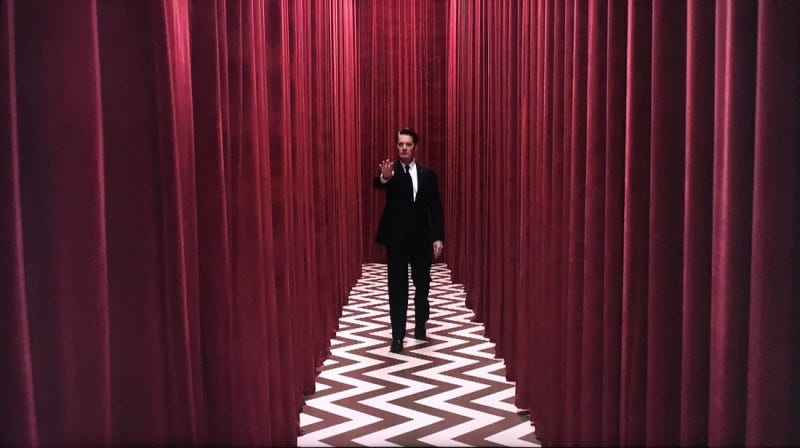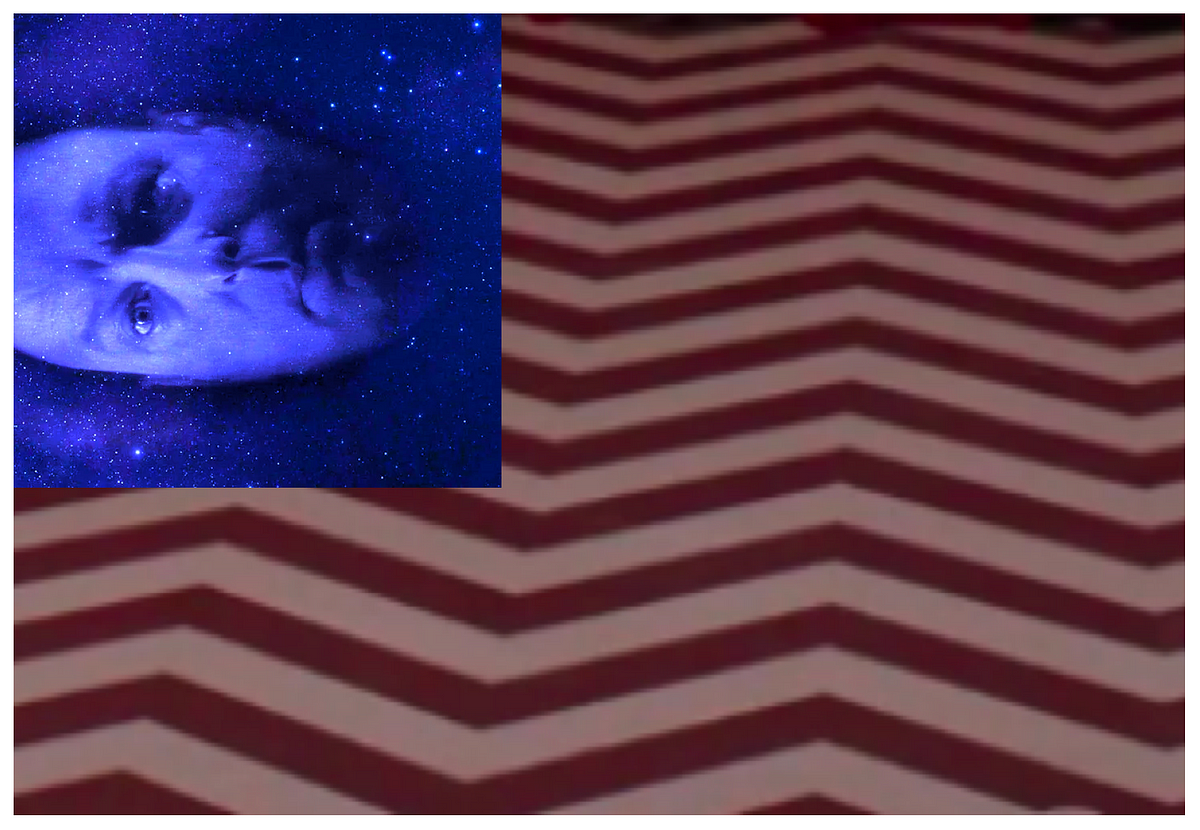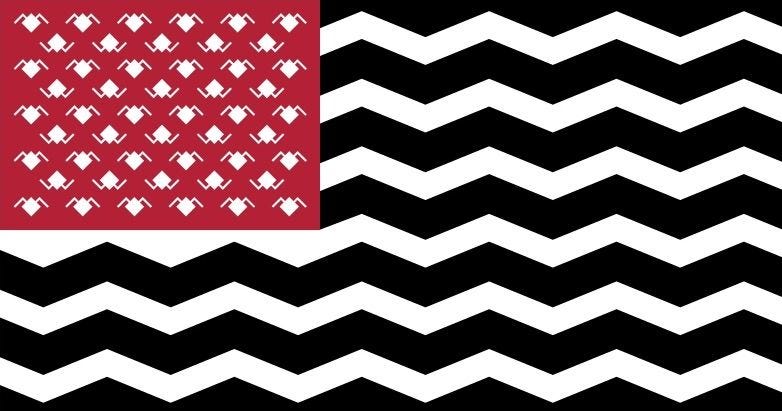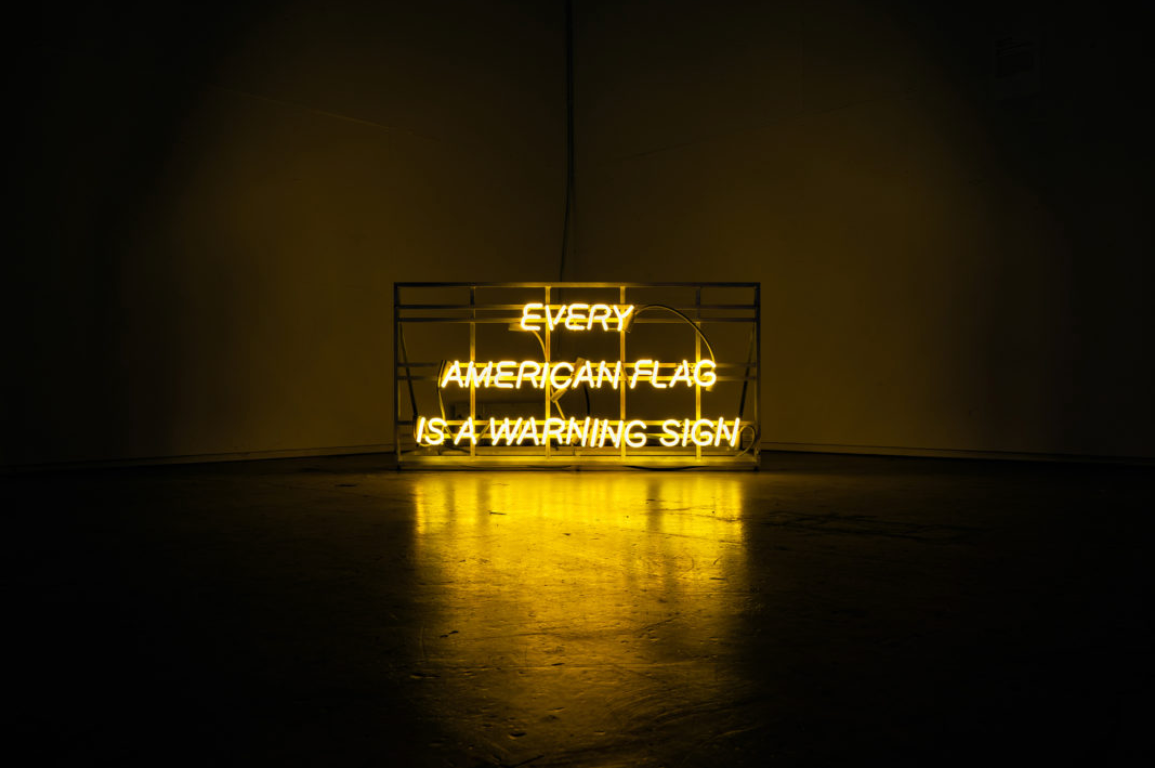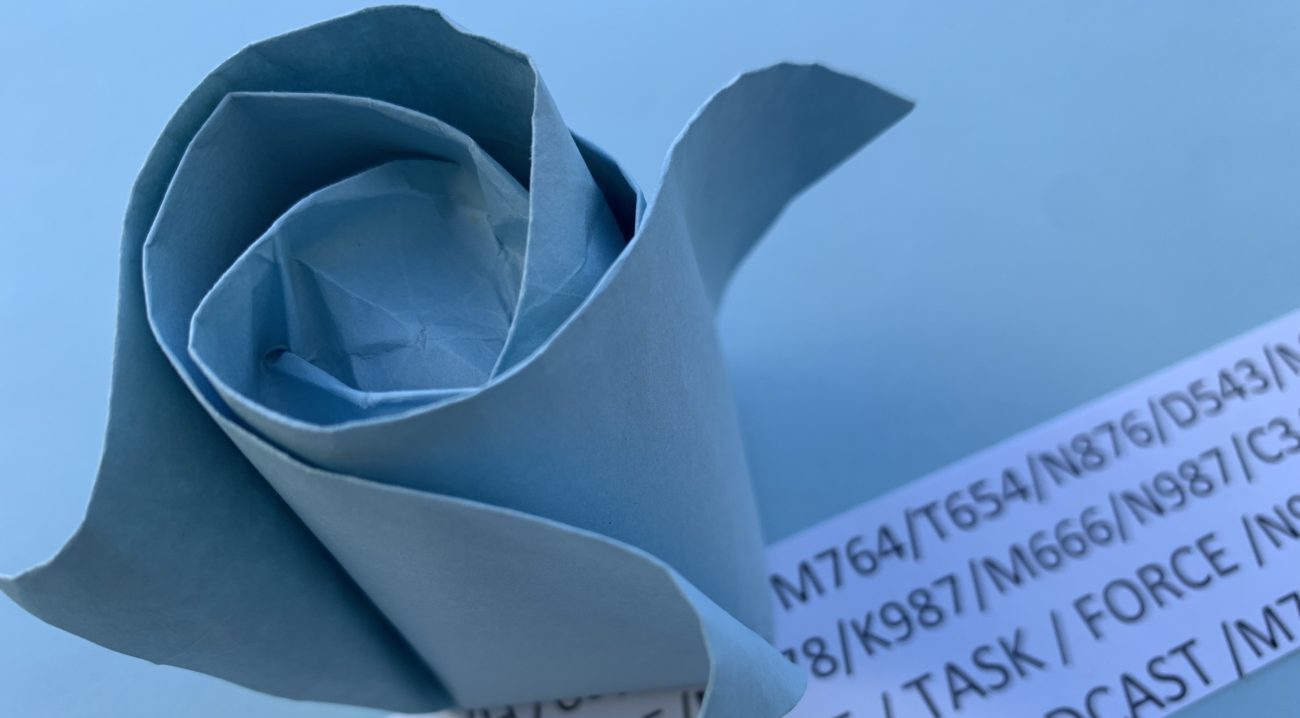“Every American Flag is a warning sign.”
Smack dab in the middle of The Return, after surviving attempted murder, Cooper sits in a waiting room next to his pseudo-wife, gazing at a flaccid U.S flag. The camera zeroes in on his face while an instrumental “America, the Beautiful” faintly plays in the background. It’s sudden, soft-core patriotism porn.
This is the first time the flag is spotlighted, and the first time a song comes from inside Cooper himself as if we can hear his thoughts, Dune style! Or, the song is non-diegetic, coming from Lynch/Frost for the audience alone; or, considering this is Twin Peaks, the song could be coming from the flag itself!
“I am the Flag, and I sound like this!”
It’s not as spooky as the tribal ululating of #6 Telephone Pole, the ominous whooshing of Ceiling Fan, the ringing of the Great Northern, or the serpentine voice of the Evolution of the Arm, but nationalist music is still pretty spooky. We mustn’t forget that we’re seeing and hearing the flag on the heels of another U.S. symbol that made its debut, with its own song, just last week in Part 8 : The Atom Bomb. Now we’re witnessing an interaction between two totally different, transformed characters, “this somber, almost pathetic sight of a once optimistic and adept person who’s now near-vegetative, staring at a symbol whose blaring, violent optimism has similarly been emptied…” (Moze Halperin)
In the world of Twin Peaks, there is no clear distinction between the living and inert. Symbols (and the objects the represent them) are also people, and human-people are often symbolic and object-like. That’s why we love it!
As a stem with an orb, the Evolution of the Arm resembles a flagstaff with finial. The red and white zig-zagging stripes of the Waiting Room resemble the red and white stripes of a flapping flag. It’s possible in Part 9 we are looking at Cooper and Janey-E mirroring Cooper and Laura in the Waiting Room (or rather, Cooper and Phillip Gerard, who was ostensibly his partner and helper for 25 years). It’s a re-staging of them in front of the EOTA.
We anthropomorphize. This absurd, cartoony, cringey yet also poignant and beautiful moving painting is interrupted by a woman’s red shoes—another complex TP symbol. Fans think they remind Cooper of Audrey, Diane, and probably Phillip Jeffries walking out of the elevator in FWWM because they remind us of those things. On another level, they’re Dorothy’s shoes from The Wizard of Oz.
An electrical outlet flies by in the background that ultimately captures Cooper’s attention, and “America, the Beautiful” shifts to spooky electrical sounds. Interestingly, the first ever “all-electric house” is on display inside a museum in Kansas. Is it intentional that during this entire scene, a covered outlet floats over Cooper’s left shoulder like an angel?

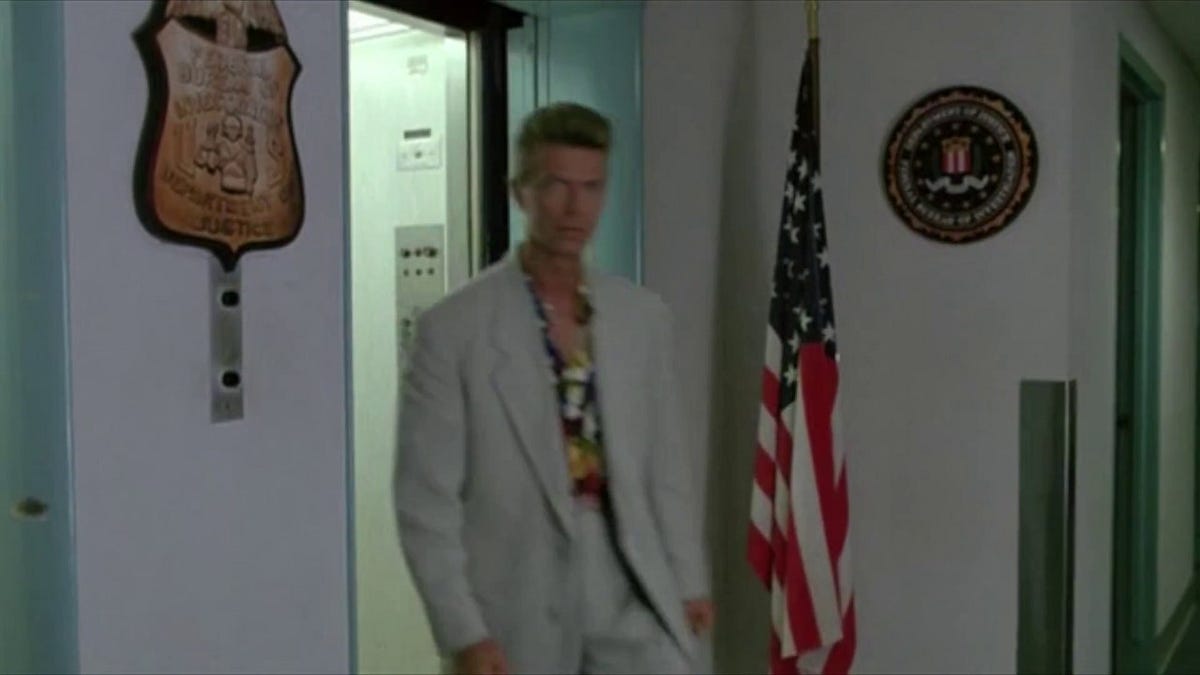
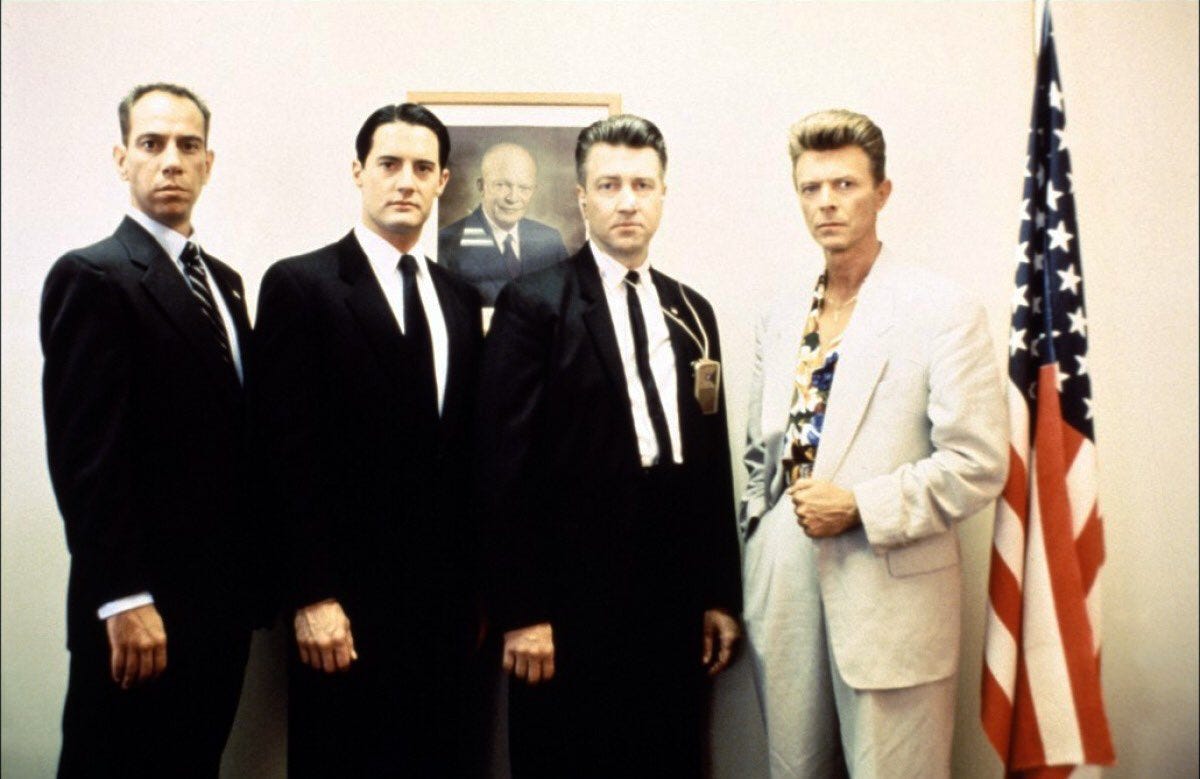
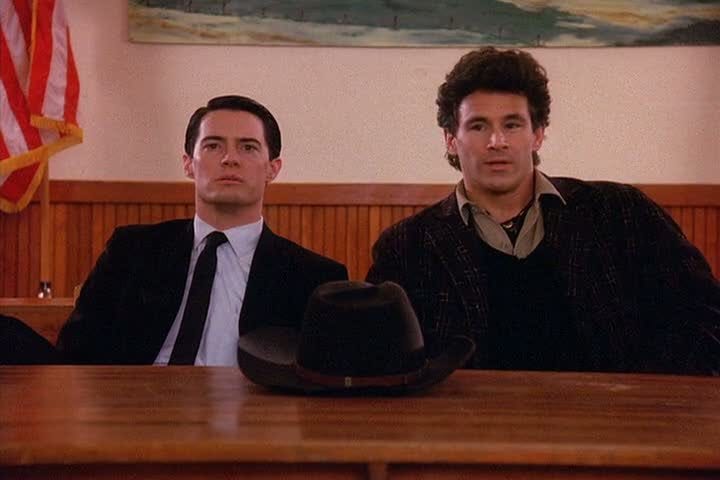




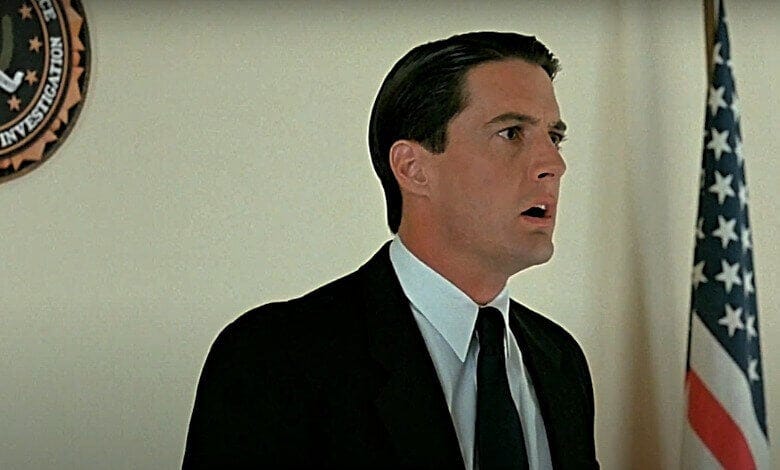


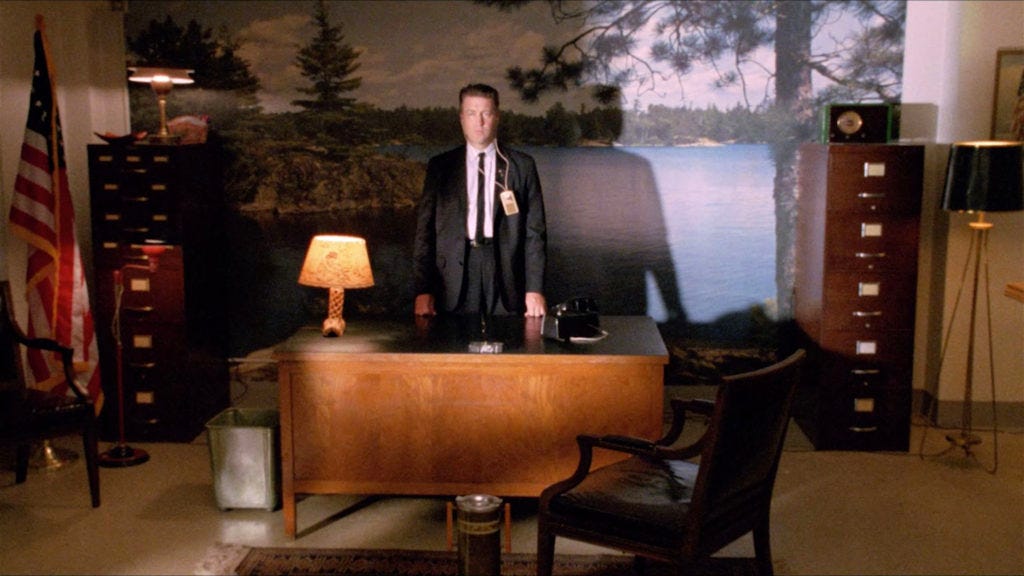
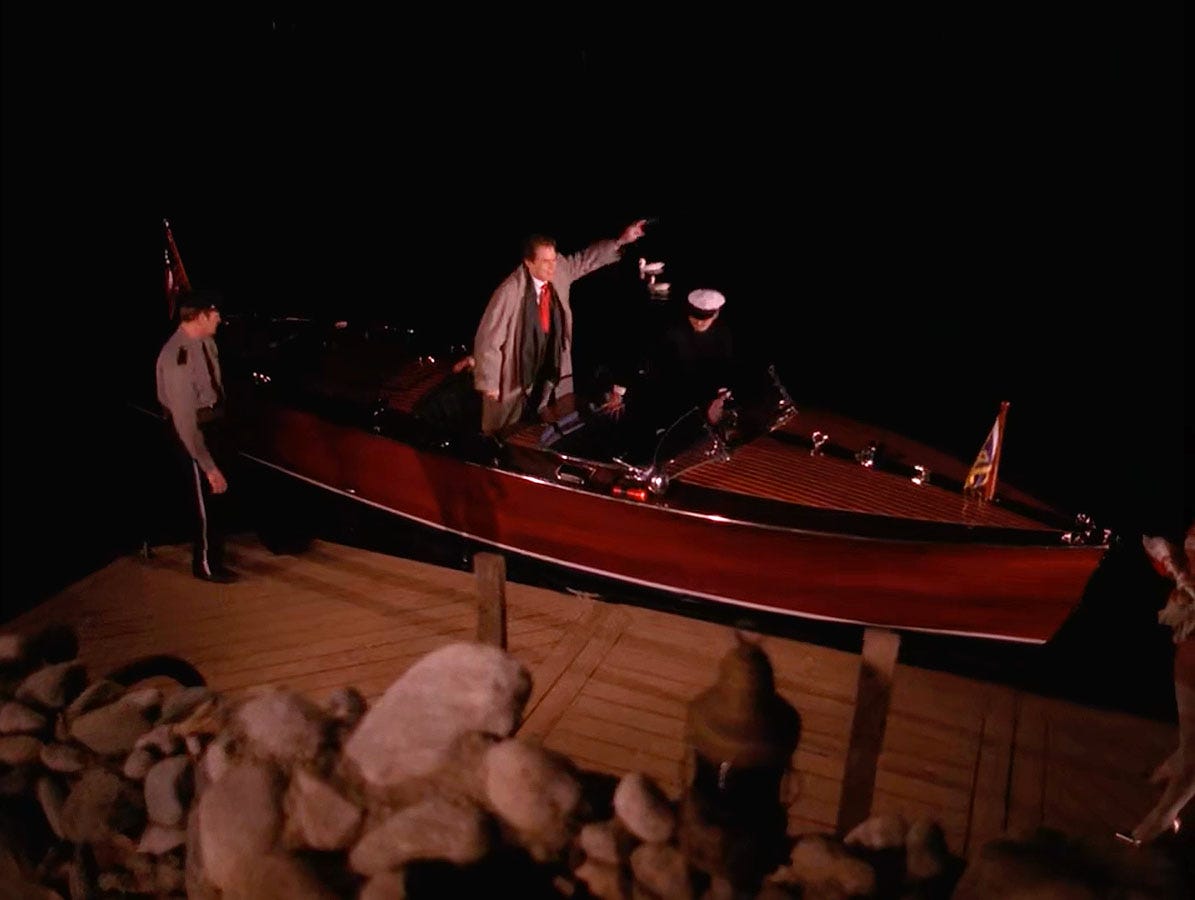

Audrey Horne (Twin Peaks) wears the flag (The US) in this 1990 cover of New York Magazine—which may as well be an advertisement for Season 3 themes. In other images above, Gordon Cole literally lines the flag up with the bomb in his office, and Dr. Amp manages to get the flag and Statue of Liberty together in his shot, for his TV show. If you blur your eyes, Lady Liberty is the Venus pudica. Behind the scenes it’s probably all the same flag prop, the one with garmonbozia-gold fringe. Notice that all the flags in Season 3 (except Dr. Amp’s) have the yellow fringe.
Its ubiquity adds to its strangeness, in Twin Peaks and in our world. Like other TP characters, it goes by different names: Stars and Stripes; Old Glory; Star-Spangled Banner; Red, White, and Blue; U.S. Flag; and The American Flag, which is probably its most common name and most misleading because America is a multi-national continent. Chilean artist Alfredo Jaar, in A Logo for America, talks about this issue—that this is most certainly not America’s flag.
What’s your name?
Made of blood, hope, and stars, according to the US Flag Code, section J, the flag is “a living thing,” with mysterious origins: we still don’t know who designed or originally manufactured it (Leepson 2006, 3)! The Betsy Ross story is made up. Historians and even her own family admit there is no physical evidence for any of it. Regardless, the colors and design were likely lifted from the East India company flag.
And although there’s a Flag Code, there is still no official document setting out the meaning of its colors and designs. One lesser known interpretation comes from The House of Representatives’ 1977 book about the flag, which states: “The star is a symbol of the heavens and the divine goal to which man has aspired from time immemorial; the stripe is symbolic of the rays of light emanating from the sun.” Say what? “Rays of light,” like the red and white stripes of the Japanese Imperial flag? I thought the stars were states, the stripes the 13 original colonies, red is blood and white is hope, or something.
Flags contain multitudes.
I am the U.S.A.
The U.S. national anthem, “The Star-Spangled Banner,” is a religious hymn in praise of the flag. Old Glory is a metonymic and ceremonial tool that’s as close to a group-owned supernatural fetish object the ‘rational’ Christian colonists can get. “Fetish” from the French for fiction, used originally by anthropologists to describe Indigenous African ceremonial objects they couldn’t understand. We can imagine outsiders, like Lakota chiefs in the 19th century, witnessing Euro-American flag protocols, watching white people salute, bow down to, and even sing to this colorful blanket, and comparing it to powerful “medicine” like sacred pipes, bundles, headdresses, and drums. It may even be a person, considering all the Plains Native men who pierce their chests and hang from poles like flags in Sundance ceremonies, or how, within some Plains “winter counts” or pictographic calendars, a drawing of two tiny U.S. flags stands for the year Lewis and Clark visited the Lakota.
An outsider may appreciate the cultural dance U.S. Army cadets enact for Flag Raising ceremonies. There is also the mind-bending U.S. Drum Core’s Color Guard dance, where a hundred synchronized performers in glittering outfits throw flags and fake rifles high into the air like batons. This is my favorite sport.
Sometimes at funerals when “Taps” is played and the red, white and blue bundle is opened like a butterfly, shaken out, and then gently closed and returned to its fetal position to be presented to a family member, I cry. It feels like a poetic reenactment of something else. In “Taps” and Twin Peaks, the music makes it powerful. We see the flag and hear the song everyone knows, a nationalist song that, like all music, provokes a response. Well-known music can even enter people who are “vegetative” and wake them up. Already knowing the song makes all the difference.
Flag Cult/ure
Emerging in the wake of the Civil War, the world-famous U.S. flag cult involves extensive taboos. Here are some protocols from the Flag Code signed into law in 1942, a “one-of-a-kind document” apparently no other nations have (Leepson 2006), one Cooper would have memorized.
(a)The flag should never be displayed with the union down, except as a signal of dire distress in instances of extreme danger to life or property. (b)The flag should never touch anything beneath it, such as the ground, the floor, water, or merchandise…. (g)The flag should never have placed upon it, nor on any part of it, nor attached to it any mark, insignia, letter, word, figure, design, picture, or drawing of any nature. (h)The flag should never be used as a receptacle for receiving, holding, carrying, or delivering anything. (i)The flag should never be used for advertising purposes in any manner whatsoever. It should not be embroidered on such articles as cushions or handkerchiefs and the like, printed or otherwise impressed on paper napkins or boxes or anything that is designed for temporary use and discard. Advertising signs should not be fastened to a staff or halyard from which the flag is flown. (j)No part of the flag should ever be used as a costume or athletic uniform. However, a flag patch may be affixed to the uniform of military personnel, firemen, policemen, and members of patriotic organizations. The flag represents a living country and is itself considered a living thing. Therefore, the lapel flag pin being a replica, should be worn on the left lapel near the heart [my italics]. (k)The flag, when it is in such condition that it is no longer a fitting emblem for display, should be destroyed in a dignified way, preferably by burning.
Most U.S. people don’t follow these rules. They disrespect their own flag so much it’s inconceivable, really! There is specifically a thing with U.S. flags and car dealerships, and of course it’s printed onto t-shirts, swimsuits, napkins, underwear, socks, wrapping paper…everything. People haphazardly stand on U.S. flag rugs. Jingoes wear them as capes, bandanas, and fanny packs. There is no common “respect” for the flag, and yet, when it stands in a corner in an official capacity, finial-crowned like royalty, it says don’t touch me.
The flag is still treated like a person by many. It’s buried or ritually burned upon retirement; like a placenta, it’s folded carefully and touched only by certain people. Flags are exposed and received with reverence. They get blessed and give blessings. They’re presented at important moments and host events like a eucharist. In a sense, the flag is comparable to corn pollen or tobacco in other traditions. It’s a spiritual or “numinous” substance, like incense or holy water, ambient, operating in the margins of consciousness (like crucifixes). Flags are even comparable to coins and racist mascots—ambient settler colonialism. Are they toxic?
Like kneeling for a cultural icon, or like crossing your heart to a crucifix, in certain settings U.S. Americans will remove their headgear and place their right hands on their hearts while staring at the flag. They also might salute it like it’s a commanding officer.
All U.S. school children learn to “pledge allegiance to the flag.” They are trained to stare at it with undivided attention with their hands on their hearts while reciting the incantation. Is this some kind of Trataka meditation or neural programming? Francis Bellamy evidently wrote the Pledge of Allegiance as a marketing idea to sell more flags to public schools. Children before WWII would click their heals together and Bellamy salute (Nazi salute) it.
U.S. sports fans will stand and turn towards it before every game. Kneeling is considered a big no-no during this special time. Citations Needed has a really great episode about this “deeply American” marriage between flags, nationalism and sports. Nima Shirazi: “In American football and baseball, F-22 flyovers are routine. 160-foot flags are draped across the field. Sporting events have become, more than ever, non-stop, almost head spinning marathons of patriotism porn.”
Placentas
Peter Sloterdjik thinks the U.S. flag cult goes all the way back to ancient Egyptian rituals of parading Pharaoh’s mummified placenta ahead of the ruler. Flags are analogs for the king’s external soul, and further relate to a theory of comfort objects—teddy bears and baby blankets: they are the missing placenta-doubles. They’re also comparable to family crests and heraldic coat of arms.
This cultural-historical connection between flags and placentas is interesting because of all the placenta imagery in Twin Peaks (like the BOB orb), and also the rise of militant pro-life movements in the early 1990s. Yale historian Harold Bloom observed in his 1992 study of a post-Christian U.S. religion that the central symbols are the flag and the fetus. They blend together with the crucifix and Christ-baby (see a hermeneutics of Christ’s penis) to become one. Marc Leepson, author of Flag: An American Biography (2006) talks about how U.S. people don’t have a monarch or a state religion, so in some ways “the flag is a substitute.” A substitute is one way to describe a fetish. Carolyn Marvin, co-author of Blood Sacrifice and the Nation: Totem Rituals and the American Flag (1999) argues the flag should be considered a “totem,” using Durkheim and Freud’s definition as “an emblem of a group’s agreement to be a group.” Marvin: “Patriotic rituals revere it as the embodiment of a bloodthirsty totem god who organizes killing energy.” Bloodthirsty totem god sounds a lot like the red, white and black Jumping Man.
An interesting bit of history is that during the late 19th and early 20th centuries, the Lakota Nation incorporated U.S. flag designs into their tobacco bags, cradle boards, vests, belts, moccasins, and jewelry. They also collected flags and wore them as blankets. Why would an “enemy” of the U.S. do this? It turns out that incorporating the flag was not only a way to ‘blend in’ and ‘own’ the colonial symbol ironically (what Homi Bhabha calls “strategic failure”), but also as code—one hidden to settlers but known to them—for recalling and celebrating victorious military actions against U.S. soldiers. The Lakota, the “Great Sioux Nation,” is technically the only nation to defeat the U.S. Army not once but twice, and in doing so earning the Stars and Stripes. Thus, this is also a Lakota flag, and at one time its presence indicated that the owner of the shirt, belt or other object fought and killed U.S.soldiers.
(The Battle of Little Big Horn took no longer than an episode of television, or “as long as it takes a grown man to eat a meal.” The U.S. army was slaughtered, and just think: they were defeated exactly 100 years after the signing of the Declaration of Independence. Can you image the centennial celebrations and flag-use around this time? Flags were everywhere, and people were scared. Their nation had just been defeated on their own battlefield twice.)
“Capturing a flag” was akin to capturing a scalp. Note that Europeans probably introduced scalping to the Americas. We have early colonial accounts, especially from the Dutch and New England colonies, where a bounty was offered for “Indian scalps,” and Mexico would famously call for Apache scalps, offering between 100 pesos and $1000 a head.
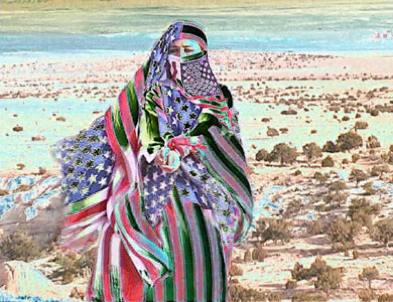
The magic of the flag and its design flowed into bodies through moccasins, vests, and tobacco bags. According to Lynn Burnette, Lakota artist and founder of the National Native American War Memorial project, warriors made a deliberate practice of capturing flags whenever the opportunity arose and “took the flags and wrapped themselves in the colors.” Burnette says they were trying to “take the power of the United States, put it on themselves, and then use the power against their enemies.” Lakota warriors also used U.S. flags to count coup.
Stealing the flag, wearing the flag, touching the flag, saluting the flag, looking at the flag, it’s all linked to power, the power of the flag to protect you like a placenta or guardian angel. Then there’s the American horror story of the Sand Creek Massacre, an example of when the presence of the U.S. flag didn’t matter. There are also the flags used as weapons during the January 6th Capital riots, and the flags fighting it out in Ben Horne’s office in Season 2. In both cases, a tiny civil war takes place inside someone’s office.
There are photographs and portraits of Native Americans wearing the U.S. flag like a ceremonial blanket. See Fritz Sholder’s paintings and 25 more important works that remix the flag. Inverted ones that signal “distress” now also signal AIM, the American Indian Movement. Russell Means: “I will wear this flag upside down as long as my people are in distress!” AIM broadcasts this symbol when they occupy spaces like Alcatraz Island and Wounded Knee.
An Indigenous art collective known as The New Red Order uses the inverted flag in their performances, or rather, they use a digital projection of it, like Spike Lee does at the end of BlacKkKlansman. Alongside AIM, the New Red Order (NRO) works with networks of “informants and accomplices” to create grounds for Indigenous futures. The name is a contradistinction to a secret society in the U.S. called “The Improved Order of the Red Men,” a whites-only fraternity, the oldest fraternity in the nation, who, like Johnny Horne, dress up and “play Indian.” Playing Indian is a tradition that goes all the way back to the donning of fake headdresses by the Sons of Liberty during the Boston Tea Party.
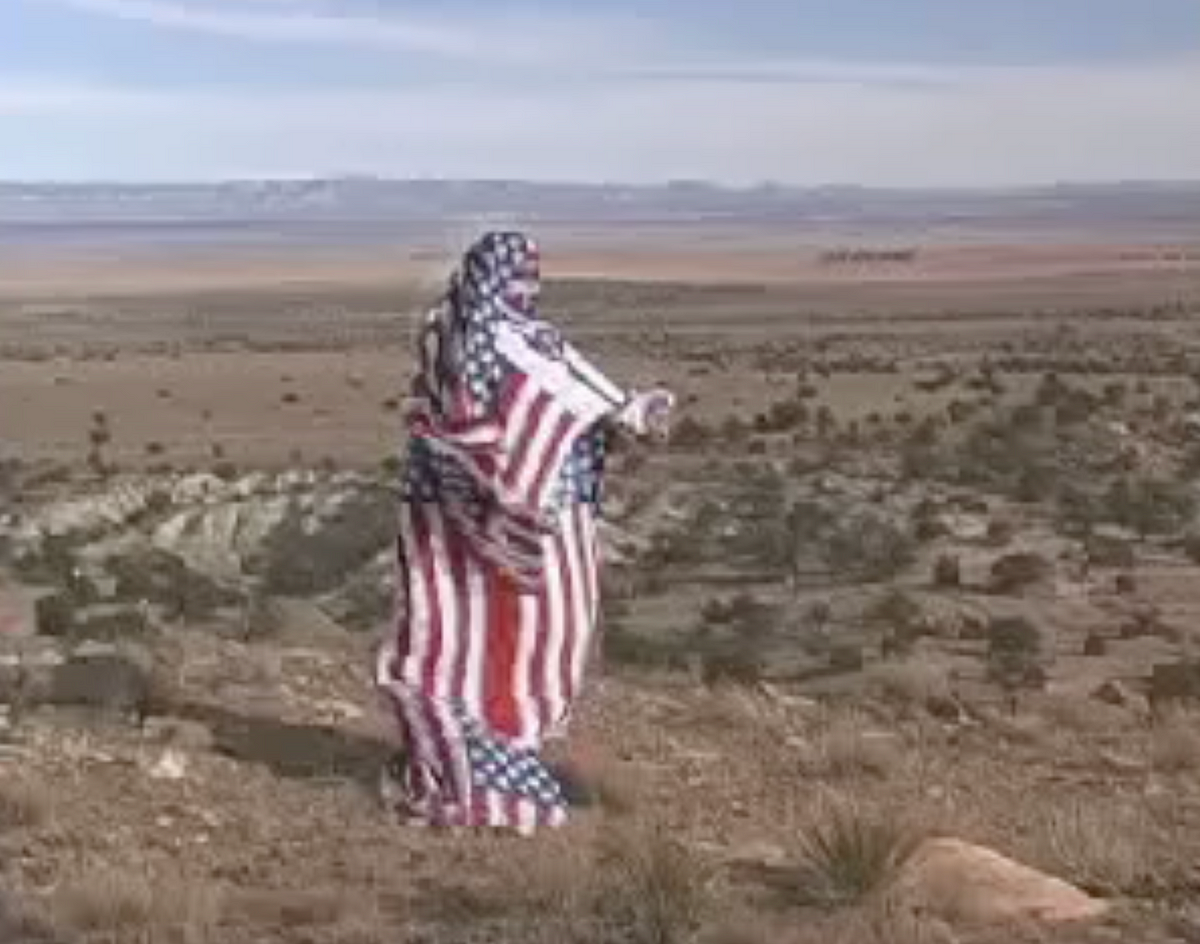
Art
In Twin Peaks and in what Arther Danto called The Artworld, flags are a medium, and contemporary artists working with them help us take different perspectives. Nicholas Galanin, for example, turns the U.S. flag into a bear rug with .50 caliber bullets for claws. Sonya Keller-Combs covers Old Glory in resin and polar bear fur so the stars and stripes look like they’re tattooed under the skin. She also cuts up a flag to make 50 tusk-shaped ‘bundles’ or apotropaic ‘charms’ called Red, White and Blue Secrets. In 2002, Diné digital artist Hulleah Tsinhnahjinnie, in collaboration with performance artist Leilani Chan, created a short film called An Aboriginal World View with Aboriginal Dreams that highlights the flag as a hijab. Throughout the film, we hear beautiful intertribal pow-wow music while a woman-of-color in a hijab and niqāb made out of Old Glories, with her hands bounded, appears and disappears around the Southwest aka Indian Country. At the end of the film, the woman (playing Jingo?) stands next to a body of water.
This was filmed over a decade before Ridwan Adhami photographed herself in a flag hijab and called it “I Am America,” which was then used by Shepard Fairy for his famous We The People illustration in 2017, used to protest the inauguration of president #45; also over a decade before Saba Ahmed, the founder of the Republican Muslim Coalition, appeared on Megyn Kelly’s Fox News program in a flag hijab to defend Muslim Americans’ constitutional right to free religion.
It was filmed the year the U.S. illegally invaded Iraq and Afghanistan, and it helps us see parallels between the United States as a foreign occupying force and a domestic colonizing force. “Indian Country” likewise is U.S. military code for a war zone.
In 2004, the 9/11 Commission concluded there was no evidence of any relationship between the Saddam Hussein regime and al-Qaeda. No stockpiles of WMDs or an active WMD program were ever found in Iraq. Iraq’s nuclear program ended in 1991 following the first Gulf War (and Seasons 1 and 2 of TP). Powell lied. Bush lied. Rumsfeld, Rice, Cheney… my god Cheney’s construction business got 3 billion from the U.S. government before the war even started, and another $39.5 billion over the course of the first decade. These grievances, murders, and young veterans who’ve killed themselves (as of 2022, around 44 veterans kill themselves every day in the U.S.A.) haunt us all, and this U.S. Global War on Terror (GWOT) turns out to be integral to the story of Twin Peaks, as well as the story of what the flag means to many people today.
Wars
More art: Sonya Clark unweaves U.S. and Confederate flags then reweaves them into other patterns, sometimes adding black thread to look like hair. Merritt Johnson, in her Exorcizing America DIY video series on YouTube, uses a razor blade to show viewers how to make a ladder out of a flag. It’s narrated in both English and Spanish. When speaking about the project, Johnson makes some really important points I think we should take some time to understand:
The US flag has been used as a symbol of settler claim, ownership and to assert the sovereignty of a settler government on Indigenous land. It’s present at borders and federal and state buildings and parks as a reminder that there is no public land, there is no acknowledgment of Indigenous connection to land alongside the US Flag, as many Indigenous nations have flags. So to make the flag into something that functions to oppose the power and sovereignty of US border enforcement makes sense to me.

Creation through destruction. Erica Lord’s American Land Reclamation Project explores the repetition of broken treaty agreements between the U.S and neighboring Indigenous nations. She uses the red stripes from the flag, the blood, to create prayer ties for each broken treaty, and then hangs them from the ceiling with sinew. Tying knots is a traditional form of praying and healing in many cultures, and often Indigenous American prayer ties are filled with tobacco. Lord’s bundles are filled with dirt from tribal lands. She installed mirrors in the square room to further multiply the prayers. I can’t help but think of the Equal Justice Initiative Community Remembrance Project, a collection of glass jars filled with dirt from the base of trees where black men were lynched. In Lord’s project, earth and its lodges are surrounded by dream-infused red fabric floating in the air. Sound familiar?
Quick tangent: At the beginning of The Return, Denise Bryson, the gender queer FBI Chief of Staff, boldly stands in front of a U.S. flag, and this makes me think of homonationalism, one of the many ways the U.S. empire coopts liberation movements to further its own global dominance. Homonationalism first appeared during the war in Iraq.
Conclusions
We don’t know where it came from. The Star-Spangled banner, and the mind it engenders, is a sort of physical egregore or tulpa that’s evolved, and Lynch/Frost turned it into a TP symbol! “The most emotional colored fabric in the world” lives rent free in all our imaginations, as global as traffic lights and Mickey Mouse. It’s on the Moon and now Mars for Christ’s sake!
Twin Peaks has to do with U.S. heritage. It’s a distillation of U.S. fantasies, and what better character embodies this than the flaccid flag? It stands there, in the middle of the series, lit up on Lynch/Frost’s stage, alongside the Convenience Store and Atom Bomb. It’s also comparable to the #6 Telephone Pole, who pops up out of nowhere from time to time, and this suggests there could be a lodge entity in there, so we better watch out!
